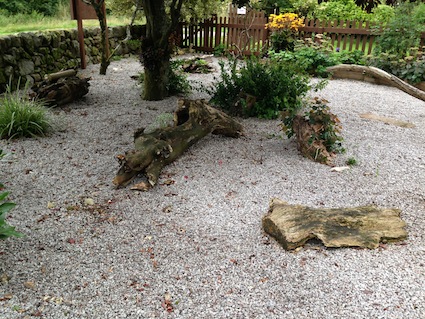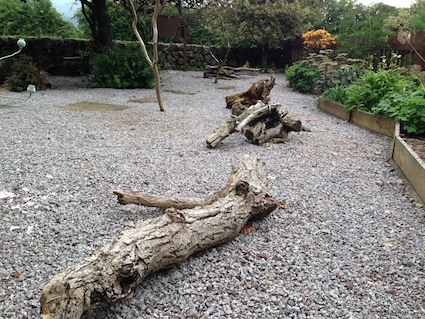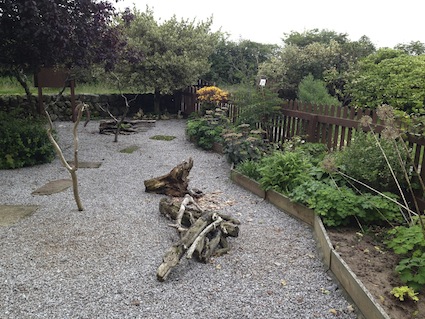I have previously blogged about RSPB Mersehead Reserve in Dumfries & Galloway and the accessible wildlife garden which took the art of container planting to a new height. This was not the only gem of a wildlife area. I found myself drooling over the spacious bird feeding garden. Most bird feeding areas I’ve seen focus on artificial feeders and pay little attention to the aesthetics of the surroundings. Here I think Ella McLellan, the former RSPB Education Officer, has demonstrated that bird feeding areas can be visually attractive, low cost, simple and so much more than a few hanging feeders.

The attention to detail has been super and worthy of schools and nurseries taking notes to adapt to their own outdoor spaces. It is reminiscent of a zen garden owing to the placement of the features and stone. Every item is there to attract and benefit visiting birds.

Firstly, you can see that the ground cover is gravel rather than soil or bark chips. This is deliberate in that it is harder for seed which falls onto the gravel to grow. It is a more hygienic surface. It is easy to move the bird feeders around to avoid build up of spilled food and therefore potential diseases for birds.

The landscape has been created on several levels. After all, different birds have different approaches to finding food. Some birds such as blackbirds like to gather from the ground. Others like to hide and find food in and amongst plants. Moveable logs near to ground level can be seen in various parts of the garden. Bird food is put into the natural cracks, lines and crevices for species such as nuthatches.
There are forked branches sticking up. These are used for hanging food. Acrobatic garden birds such as great tits and blue tits can access the food hung here.

At the edges of the gravel are an overhanging tree and hedge which provide protection for the birds if they feel threatened. All the plants in the raised beds provide food too. The surrounding flower beds are planted with nectar rich species, which provide foraging areas for bees , butterflies, hoverflies and other insects. These in turn provide additional food for birds, particularly during the breeding season as young birds are fed mainly insects until they leave the nest. Field teacher Ella McLellan is quite strict about what plants are allowed in this area, and has in the past asked for things to be removed which although they may have looked ‘pretty’ did not provide enough ‘feeding’ potential.
A useful webpage to visit with more detailed information about feeding birds can be found on the RSPB website. The benefits of a bird feeding area are numerous. Firstly, by planting bird friendly plants and native trees, flowers and shrubs, the biodiversity of an area is increased. This will help attract more insects and other animals too. So children have a greater chance to observe and learn about a larger range of species.
Secondly, the birds come to your school or outdoor space! Give birds time to learn of your feeding area. Do not expect an instant flocking of birdlife.
If you have a bird hide or place to watch the birds, then all sorts of curriculum activities can arise. For example:
- Data Handling: Ask your class what sort of information about birds can be gathered by watching visiting birds come to the area. This might extend to discovering favourite foods, places to eat, different behaviours and the variety of species. THe RSPB run a national Big School Birdwatch during January and February each year. THere are lots of online resources to support the birdwatch. This includes whiteboard friendly graphs and data gathering applications.
- Science: How easy is it to identify a bird from a chart or key? What tips and advice can children offer? Which is the best way to identify a bird? It can be helpful for children to learn the correct names for the different parts of a birds body. This leads to more accurate descriptions and identification.
- Children can also find out about bird friendly plants. For example, growing sunflowers is beneficial as the seeds are a common bird food. Having a compost bin or wormery can provide a source of worms for robins and other garden birds.
- Art & Design: Children may enjoy sketching birds they see in the feeding area. Have A3 clipboards for this purpose. Viewing cards – simply a square cardboard frame, can help children focus on a particular bird.
- Technologies: Children can research bird feeders and water vessels online and then create their own from junk or natural materials. Which ideas are the simplest yet most effective? What food can we put out for birds which is also suitable for human consumption? Is food which is good for humans, always good for birds?
- Religious and Moral Education: Caring for creatures is part of most religions’ beliefs. What routines need to be put in place to ensure that a bird feeding area is well-maintained and looked after?
Feeding birds and providing water
There are lots of options for feeding birds aside from providing commercially bought food. Children can have fun designing their own bird food recipes from ingredients such as suet, seeds, apples, pears, brambles and plums (British fruit), cheese, cooked rice, soaked raisins.
Remember that bird feeding areas will need cleaned regularly – ideally weekly – to avoid the build up of old food that becomes toxic to birds. Likewise water needs changed regularly – ideally daily. The RSPB has specific advice to help keep your garden birds healthy.
Winter is when the birds need our help most as their natural food sources become scarce, but it is perfectly alright to feed birds all the year round. Always remember to have a source of fresh water available too.
All-in-all, a bird watching project is simple, requires few resources and will capture the imagination and interest of many children. Feed the birds and you may help feed children’s curiosity about the world. Remember to sign up for the RSPB Big Schools‘ Birdwatch and enjoy participating in this wonderful Citizen Science project.
This blog post was originally published in November 2013. Although this bird feeding area is no longer present at RSPB Mersehead, the suggestions and advice in this blog post remain helpful and relevant for schools and ELC settings. Furthermore almost all RSPB reserves provide wonderful and unique examples of low cost ways of developing bird feeding areas and nature-friendly design features that can be adapted for a school grounds or outdoor setting. Please also remember Bird Flu is rife so do not touch any dead bird you encounter. Follow your local and national updates at NatureScot and other UK Government Agencies




















Trackbacks/Pingbacks